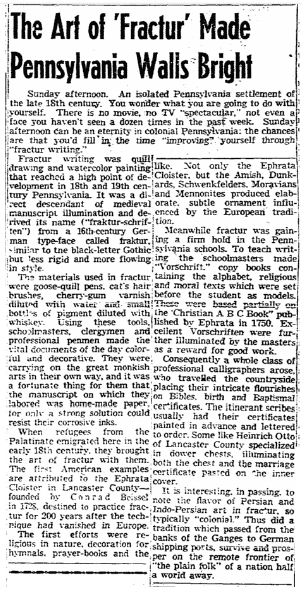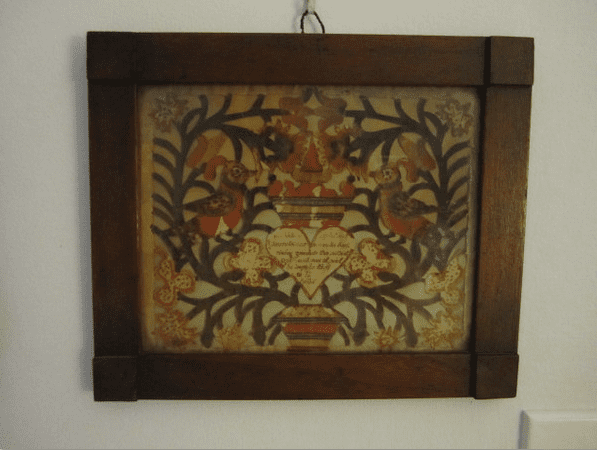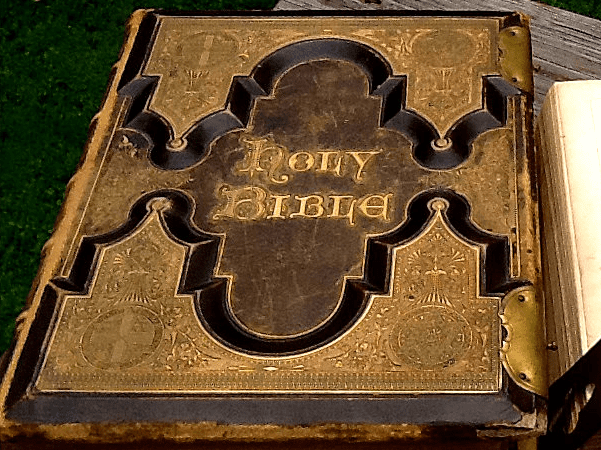Introduction: In this article, Mary Harrell-Sesniak writes about using family Bible records and an interesting folk art called “frakturs” to document early family history. Mary is a genealogist, author and editor with a strong technology background.
I was recently asked to be part of a “Brick Wall” genealogical panel, whereby researchers submit a series of questions regarding their seemingly unsolvable ancestral proofs.
Many family researchers get stuck at dead-ends due to the loss of church and civil records, and don’t know where to turn next in pursuing their family history.
So if you can’t find an official genealogical proof document, what should you do? One good solution is to look for a family record, such as notes recorded in family Bibles. Another good genealogical resource is a fraktur, a type of folk art, mostly created to commemorate births, baptisms, and marriages.
Frakturs (or Fraktur Schrift) was originally an early type of black letter printing (or calligraphy) found in Germany. Later it expanded into a delightful type of decorative pictorial or manuscript art, popularized by Pennsylvania Mennonites at Ephrata, as described in this 1955 article from GenealogyBank’s historical newspaper archives.

Fraktur examples are often found in museums, and are advertised for high amounts on popular auction sites such as eBay. Numerous artifacts are in private collections, such as this framed fraktur which was given by one of my ancestors to her spouse in commemoration of their marriage.

Beyond delving into family collections, how might one locate family Bibles and frakturs?
An easy method is to search military pension records. If a spouse survived her veteran husband and wished to collect a pension, proof of marriage was required.
Typically, a widow would submit a church record or a letter from a town clerk certifying a civil registration. In this example from 1840, James P. Terry of Somers, Tolland, Connecticut, certified the marriage of Stephen Chapel and Lucy Russel on 25 October 1795.
However, if a civil or court record was unavailable (perhaps lost to fire or other disaster), the surviving family member might resort to submitting original pages from the family Bible or a fraktur.
A few of these proof-of-marriage document submissions were returned to the families—but many were not, and numerous examples still exist within the National Archives. Most are digitized (generally in black and white) within pension files, such as this one for Revolutionary War soldier John Tomlin and his wife Jane Chamblin.
As descendants find their ancestors’ frakturs, they are often posted on websites. You can find these posted frakturs using my “visual” method.
How to Find Your Family’s Fraktur
1) Open your favorite search engine (mine is Google).
2) Search for “fraktur” or “Bible” followed by a keyword such as a surname, or a phrase such as “Revolutionary War.”
3) Click on the “Images” tab at the top of the resulting search results page—and voilà: pages and pages of images of frakturs appear. Some will be links to books and references, but most will direct you to digitized images. (Note: if using Google Chrome, you can explore additional searching options under the “More” or “Search Tools” options.)
4) Bookmark the images you are interested in for later reference, or add them to a Pinterest.com board. Pinterest is a “content sharing service that allows members to ‘pin’ images, videos and other objects to their pinboard.”
Google Images search results for “fraktur” and the surname “Tomlin”:
Search results for family “Bible records”:
You can search Pinterest for genealogy links, such as GenealogyBank’s Pinterest boards at
http://pinterest.com/genealogybank/, or my recently established Frakturs and Family Bible Records Pinterest board at http://pinterest.com/compmary/frakturs-and-family-bible-records/.
For more information on frakturs, visit the Ephrata Cloister website.
